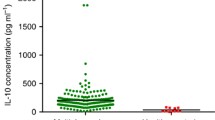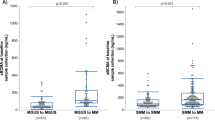Abstract
The IL-2/IL-2 receptor (IL-2R) system plays a central role in maintaining normal T cell immunity, and its disturbance is associated with several hematologic disorders. Studies have found in several types of lymphoma that abnormal amounts of soluble IL-2R (sIL-2R) may result in imbalance of the IL-2/IL-2R system and hence of the T cell immunoregulation. Whether the level of sIL-2R in blood could predict treatment outcomes or not needs to be investigated in multiple myeloma (MM) patients. The level of sIL-2R in serum was measured using enzyme-linked immunosorbent assay (ELISA) in 81 patients with newly diagnosed MM. Twenty-six patients (32.1%) were treated with bortezomib-based regimens and 55patients (67.9%) received old drugs-based regimens. The mean concentration of sIL-2R for myeloma patients was 8.51 ng/ml, significantly higher than that of healthy controls (0.56 ng/ml, p < 0.0001). The best cutoff value for sIL-2R in predicting high risk for disease progression is 6.049 ng/ml with an area under curve (AUC) of 0.665 (p = 0.013). Thirty-six patients (44.4%) were classified as higher sIL-2R level group (> 6.049 ng/ml), and 45 patients (55.6%) as lower group (≤ 6.049 ng/ml). The overall response rate (ORR) was 60.0% in lower sIL-2R level group, and 41.7% in higher level group (p = 0.156). The median progression-free survival (PFS) and overall survival (OS) was 12 months (range, 2.0–65 months) and 20 months (range, 2.0–118 months), respectively. In a multivariate survival analysis, including Eastern Cooperative Oncology Group performance status score, treatment response, and sIL-2R level, it was found that all these three parameters were significantly independent prognostic factors for PFS (p = 0.032, 0.016, and 0.043, respectively), but none factors maintained their value in predicting OS. Subgroup analysis revealed that high level of sIL-2R is correlated with significantly inferior PFS in patients treated with bortezomib-based regimens (p = 0.004). Serum sIL-2R level is an independent prognostic factor for PFS, indicating novel drugs targeting the imbalance of IL-2/IL-2R system may be a promising strategy in MM.




Similar content being viewed by others
References
Sonneveld P, Goldschmidt H, Rosinol L, Blade J, Lahuerta JJ, Cavo M, Tacchetti P, Zamagni E, Attal M, Lokhorst HM, Desai A, Cakana A, Liu K et al (2013) Bortezomib-based versus nonbortezomib-based induction treatment before autologous stem-cell transplantation in patients with previously untreated multiple myeloma: a meta-analysis of phase III randomized, controlled trials. J Clin Oncol 31(26):3279–3287
Palumbo A, Anderson K (2011) Multiple myeloma. N Engl J Med 364(11):1046–1060
Raab MS, Podar K, Breitkreutz I, Richardson PG, Anderson KC (2009) Multiple myeloma. Lancet 374(9686):324–339
Kumar SK, Rajkumar SV, Dispenzieri A, Lacy MQ, Hayman SR, Buadi FK, Zeldenrust SR, Dingli D, Russell SJ, Lust JA, Greipp PR, Kyle RA, Gertz MA (2008) Improved survival in multiple myeloma and the impact of novel therapies. Blood 111(5):2516–2520
Chanan-Khan AA, Giralt S (2010) Importance of achieving a complete response in multiple myeloma, and the impact of novel agents. J Clin Oncol 28(15):2612–2624
Harousseau JL, Attal M, Avet-Loiseau H (2009) The role of complete response in multiple myeloma. Blood 114(15):3139–3146
Kapoor P, Kumar SK, Dispenzieri A, Lacy MQ, Buadi F, Dingli D, Russell SJ, Hayman SR, Witzig TE, Lust JA, Leung N, Lin Y, Zeldenrust SR et al (2013) Importance of achieving stringent complete response after autologous stem-cell transplantation in multiple myeloma. J Clin Oncol 31(36):4529–4535
Rubin LA, Kurman CC, Fritz ME, Biddison WE, Boutin B, Yarchoan R, Nelson DL (1985) Soluble interleukin 2 receptors are released from activated human lymphoid cells in vitro. J Immunol 135(5):3172–3177
Rubin LA, Galli F, Greene WC, Nelson DL, Jay G (1990) The molecular basis for the generation of the human soluble interleukin 2 receptor. Cytokine 2(5):330–336
Rubin LA, Nelson DL (1990) The soluble interleukin-2 receptor: biology, function, and clinical application. Ann Intern Med 113(8):619–627
Bien E, Balcerska A (2008) Serum soluble interleukin 2 receptor alpha in human cancer of adults and children: a review. Biomarkers 13(1):1–26
Pizzolo G, Ambrosetti A, Vinante F, Chilosi M, Semenzato G (1991) Serum interleukin-2 receptor as index of tumor burden in hairy cell leukemia. Blood 77(11):2540–2542
Kamihira S, Atogami S, Sohda H, Momita S, Yamada Y, Tomonaga M (1994) Significance of soluble interleukin-2 receptor levels for evaluation of the progression of adult T-cell leukemia. Cancer Am Cancer Soc 73(11):2753–2758
Pui CH, Ip SH, Iflah S, Behm FG, Grose BH, Dodge RK, Crist WM, Furman WL, Murphy SB, Rivera GK (1988) Serum interleukin 2 receptor levels in childhood acute lymphoblastic leukemia. Blood 71(4):1135–1137
Semenzato G, Foa R, Agostini C, Zambello R, Trentin L, Vinante F, Benedetti F, Chilosi M, Pizzolo G (1987) High serum levels of soluble interleukin 2 receptor in patients with B chronic lymphocytic leukemia. Blood 70(2):396–400
Pizzolo G, Chilosi M, Vinante F, Dazzi F, Lestani M, Perona G, Benedetti F, Todeschini G, Vincenzi C, Trentin L, Et A (1987) Soluble interleukin-2 receptors in the serum of patients with Hodgkin’s disease. Br J Cancer 55(4):427–428
Chilosi M, Semenzato G, Vinante F, Menestrina F, Piazzola E, Focchiatti V, Sabbioni R, Zanotti R, Pizzolo G (1989) Increased levels of soluble interleukin-2 receptor in non-Hodgkin’s lymphomas. Relationship with clinical, histologic, and phenotypic features. Am J Clin Pathol 92(2):186–191
Sakata H, Murakami S, Hirayama R (2002) Serum soluble interleukin-2 receptor (IL-2R) and immunohistochemical staining of IL-2R/Tac antigen in colorectal cancer. Int J Clin Oncol 7(5):312–317
Tartour E, Mosseri V, Jouffroy T, Deneux L, Jaulerry C, Brunin F, Fridman WH, Rodriguez J (2001) Serum soluble interleukin-2 receptor concentrations as an independent prognostic marker in head and neck cancer. Lancet 357(9264):1263–1264
Ichikawa A, Kinoshita T, Watanabe T, Kato H, Nagai H, Tsushita K, Saito H, Hotta T (1997) Mutations of the p53 gene as a prognostic factor in aggressive B-cell lymphoma. N Engl J Med 337(8):529–534
Hara T, Tsurumi H, Takemura M, Goto H, Yamada T, Sawada M, Takahashi T, Moriwaki H (2000) Serum-soluble fas level determines clinical symptoms and outcome of patients with aggressive non-Hodgkin’s lymphoma. Am J Hematol 64(4):257–261
Goto N, Tsurumi H, Takemura M, Hara T, Sawada M, Kasahara S, Kanemura N, Yamada T, Shimizu M, Takahashi T, Tomita E, Seishima M, Takami T et al (2006) Serum-soluble tumor necrosis factor receptor 2 (sTNF-R2) level determines clinical outcome in patients with aggressive non-Hodgkin’s lymphoma. Eur J Haematol 77(3):217–225
Schutt P, Ebeling P, Buttkereit U, Brandhorst D, Opalka B, Poser M, Muller S, Flasshove M, Moritz T, Seeber S, Nowrousian MR (2005) Thalidomide in combination with dexamethasone for pretreated patients with multiple myeloma: serum level of soluble interleukin-2 receptor as a predictive factor for response rate and for survival. Ann Hematol 84(9):594–600
Kuku I, Bayraktar MR, Kaya E, Erkurt MA, Bayraktar N, Cikim K, Aydogdu I (2005) Serum proinflammatory mediators at different periods of therapy in patients with multiple myeloma. Mediat Inflamm 2005(3):171–174
Vacca A, Di Stefano R, Frassanito A, Iodice G, Dammacco F (1991) A disturbance of the IL-2/IL-2 receptor system parallels the activity of multiple myeloma. Clin Exp Immunol 84(3):429–434
Yang ZZ, Grote DM, Ziesmer SC, Manske MK, Witzig TE, Novak AJ, Ansell SM (2011) Soluble IL-2Ralpha facilitates IL-2-mediated immune responses and predicts reduced survival in follicular B-cell non-Hodgkin lymphoma. Blood 118(10):2809–2820
Kandefer-Szerszen M, Legiec W, Dmoszynska A, Rzeski W (1997) Detection of soluble IL-2 receptor in the serum and bone marrow of patients with minimal residual hematological malignancies: induction under therapy with IL-2. Arch Immunol Ther Exp 45(5–6):443–448
Rosalia RA, Arenas-Ramirez N, Bouchaud G, Raeber ME, Boyman O (2014) Use of enhanced interleukin-2 formulations for improved immunotherapy against cancer. Curr Opin Chem Biol 23:39–46
Caruso C, Candore G, Cigna D, Colucci AT, Modica MA (1993) Biological significance of soluble IL-2 receptor. Mediat Inflamm 2(1):3–21
Lindqvist CA, Christiansson LH, Simonsson B, Enblad G, Olsson-Stromberg U, Loskog AS (2010) T regulatory cells control T-cell proliferation partly by the release of soluble CD25 in patients with B-cell malignancies. Immunology 131(3):371–376
Singhal S, Mehta J, Desikan R, Ayers D, Roberson P, Eddlemon P, Munshi N, Anaissie E, Wilson C, Dhodapkar M, Zeddis J, Barlogie B (1999) Antitumor activity of thalidomide in refractory multiple myeloma. N Engl J Med 341(21):1565–1571
Kumar SK, Dispenzieri A, Lacy MQ, Gertz MA, Buadi FK, Pandey S, Kapoor P, Dingli D, Hayman SR, Leung N, Lust J, McCurdy A, Russell SJ et al (2014) Continued improvement in survival in multiple myeloma: changes in early mortality and outcomes in older patients. Leukemia 28(5):1122–1128
Desai S, Maurin M, Smith MA, Bolick SC, Dessureault S, Tao J, Sotomayor E, Wright KL (2010) PRDM1 is required for mantle cell lymphoma response to bortezomib. Molecular cancer research 8(6):907–918
Ottaiano A, Leonardi E, Simeone E, Ascierto PA, Scala S, Calemma R, Bryce J, Caraco C, Satriano RA, Gianfranco N, Franco R, Botti G, Castello G (2006) Soluble interleukin-2 receptor in stage I-III melanoma. Cytokine 33(3):150–155
Talpur R, Jones DM, Alencar AJ, Apisarnthanarax N, Herne KL, Yang Y, Duvic M (2006) CD25 expression is correlated with histological grade and response to denileukin diftitox in cutaneous T-cell lymphoma. J Investig Dermatol 126(3):575–583
Acknowledgments
We appreciate the support from Dr. Hao Chen, who helped us measure the level of sIL-2R in this study. This work received grant support from the National Natural Science Foundation of China (contract/grant number: 81400159) and Pearl River Nova Program of Guangzhou (contract/grant number: 201710010161).
Author information
Authors and Affiliations
Contributions
LW conceived and designed the experiments. LW, JHW, WJL, WDW, and HW performed the experiments. LW and WDW analyzed the data. YL, ZJX, XQC, and QRG contributed to reagents/materials/analysis tools. JHW, LW, WJL, WDW, and HW wrote the paper. All authors have read and approved the final version of this manuscript.
Corresponding author
Ethics declarations
Conflict of interest
The authors declare that they have no conflicts of interest relevant to the manuscript submission.
Ethics statement
All procedures performed in this study were in accordance with the ethical standards of the institutional and/or national research committee and with the 1964 Helsinki Declaration and its later amendments or comparable ethical standards. For this retrospective study, formal consent is not required.
Informed consent statement
Informed consent was obtained from all individual participants included in the study.
Electronic supplementary material
Supplementary Figure 1
Level of sIL-2R in three representative patients at different timepoints. The level of sIL-2R significantly decreased when CR was achieved and increased at relapse. (JPEG 90 kb)
Rights and permissions
About this article
Cite this article
Wang, L., Wang, Jh., Liu, Wj. et al. High level of soluble interleukin-2 receptor in serum predicts treatment resistance and poor progression-free survival in multiple myeloma. Ann Hematol 96, 2079–2088 (2017). https://doi.org/10.1007/s00277-017-3125-4
Received:
Accepted:
Published:
Issue Date:
DOI: https://doi.org/10.1007/s00277-017-3125-4




